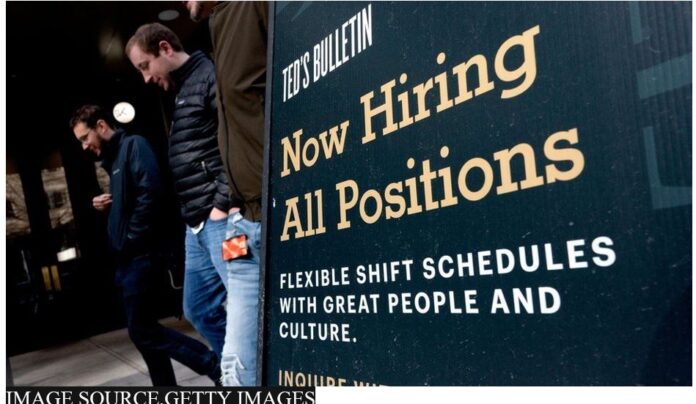US unemployment claims down as jobs growth remains strong
By Jeph Ajobaju, Chief Copy Editor
Jobless benefit claims in the United States are at their 53-year low as jobs growth remains strong, reflecting economic expansion, even though Joe Biden’s approval ratings are in the low 40s due to high inflation fuelled by rising gas prices.
The US economy added 678,000 jobs in February, far ahead of expectations, as activity continued to rebound.
Unemployment rate dipped to 3.8 per cent, according to the US Bureau of Labor Statistics, which also reported widespread job growth, led by gains in leisure and hospitality, professional and business services, health care, and construction.
The number of new jobs added was well above analysts’ estimates of about 400,000 new roles. Companies also added more jobs in January.
And last week, just 187,000 people filed for unemployment, the Labor Department reported. That was down roughly 28,000 from the previous week.
The BBC reports that the figures show a stark turnaround in the job market in the US since the start of the coronavirus pandemic.
The news sparked several historic comparisons on social media, with some sharing photos of Woodstock music fest.
“The last time jobless claims fell this low was the same year we landed folks on the moon,” said Rep Ted Lieu, Democrat from California.
“The last time weekly jobless claims were this low The Beatles were still together,” added Rep Don Beyer, Democrat of Virginia.
The US economy has many looking back to the past at the moment, but it hasn’t been easy for economists and analysts to settle on the right historic analogies.
When lockdowns hit two years ago, the weekly jobless report hit record highs, with claims eventually exceeding six million.
But the economy, helped along by a massive government stimulus programme, has since roared back with a strength that surprised most analysts.
Growth jumped 5.7 per cent last year, while payrolls have been expanding at a healthy clip, increasing by more than 600,000 last month, helping to cut the jobless rate to 3.8 per cent.
The latest report highlighted the tight labour market, analysts said.
__________________________________________________________________
Related articles:
US inflation climbs highest in 40 years
US ranks 27th in global corruption. UK 78th, Nigeria 154th
Upsurge in ‘smash-and-grab’ crimes across US cities
Billionaires Bezos and Musk dodge US tax to stay rich
________________________________________________________________
Concerns about historic inflation rate
Biden has sought to claim credit for the gains, pointing to Democratic spending plans and progress controlling coronavirus under his watch.
He celebrated the report, citing it as another sign of a “historic economic recovery”.
But surveys show the public remains worried about the economy, reflecting prices that are increasing at a pace not seen in 40 years.
Many in the business world are haunted by comparisons to the 1970s, when the US was hit by so-called stagflation – when growth slowed even as price increases spiralled, driven in part by oil shocks.
David Rosenberg, head of the Toronto-based economic research firm Rosenberg Research, said economic indicators – including low jobless claims – suggest that America’s economy is headed for a recession – as it was at the end of 1969.
But that doesn’t mean the US economy is in for a repeat of 1970s-style problems, he told the BBC.
He said inflation pressures driven by supply shocks from the pandemic and Russia’s invasion of Ukraine will eventually abate.
And he expects productivity gains to drive growth, pointing to investments companies have accelerated in areas like automation since the pandemic.
“That is where the comparison to the 1970s really falls flat on its face,” he said. He thinks a better comparison is the temporary inflation seen after World War One.
‘Uncertainty is rife’
Brad DeLong, economics professor at the University of California, said the US should try to avoid that example.
To control price increases, the US central bank at that time doubled interest rates from 3.75 per cent to 7 per cent – a move prominent economists have since judged as moving too late and too far, he noted.
He favours comparisons from the late 1940s and early 1950s, as the economy shifted in response to World War Two and the Korean and Cold Wars.
“I could be wrong. Uncertainty is rife. Everyone right now is reaching into the past and seeking for their favourite past historical inflationary episode as an analogy,” he said.
“Maybe we will see something completely new.”













